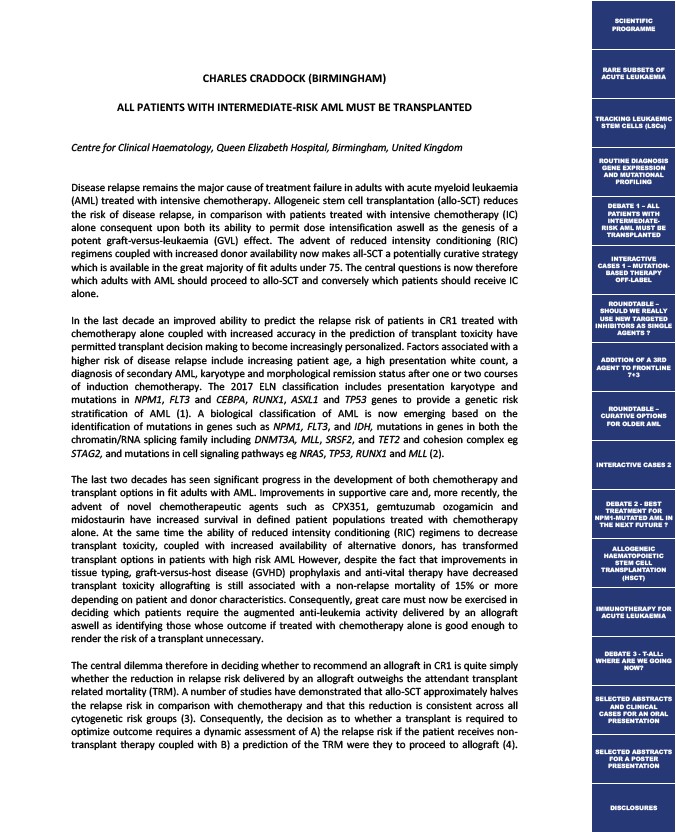
CHARLES CRADDOCK (BIRMINGHAM)
ALL PATIENTS WITH INTERMEDIATE-RISK AML MUST BE TRANSPLANTED
Centre for Clinical Haematology, Queen Elizabeth Hospital, Birmingham, United Kingdom
Disease relapse remains the major cause of treatment failure in adults with acute myeloid leukaemia
(AML) treated with intensive chemotherapy. Allogeneic stem cell transplantation (allo-SCT) reduces
the risk of disease relapse, in comparison with patients treated with intensive chemotherapy (IC)
alone consequent upon both its ability to permit dose intensification aswell as the genesis of a
potent graft-versus-leukaemia (GVL) effect. The advent of reduced intensity conditioning (RIC)
regimens coupled with increased donor availability now makes all-SCT a potentially curative strategy
which is available in the great majority of fit adults under 75. The central questions is now therefore
which adults with AML should proceed to allo-SCT and conversely which patients should receive IC
alone.
In the last decade an improved ability to predict the relapse risk of patients in CR1 treated with
chemotherapy alone coupled with increased accuracy in the prediction of transplant toxicity have
permitted transplant decision making to become increasingly personalized. Factors associated with a
higher risk of disease relapse include increasing patient age, a high presentation white count, a
diagnosis of secondary AML, karyotype and morphological remission status after one or two courses
of induction chemotherapy. The 2017 ELN classification includes presentation karyotype and
mutations in NPM1, FLT3 and CEBPA, RUNX1, ASXL1 and TP53 genes to provide a genetic risk
stratification of AML (1). A biological classification of AML is now emerging based on the
identification of mutations in genes such as NPM1, FLT3, and IDH, mutations in genes in both the
chromatin/RNA splicing family including DNMT3A, MLL, SRSF2, and TET2 and cohesion complex eg
STAG2, and mutations in cell signaling pathways eg NRAS, TP53, RUNX1 and MLL (2).
The last two decades has seen significant progress in the development of both chemotherapy and
transplant options in fit adults with AML. Improvements in supportive care and, more recently, the
advent of novel chemotherapeutic agents such as CPX351, gemtuzumab ozogamicin and
midostaurin have increased survival in defined patient populations treated with chemotherapy
alone. At the same time the ability of reduced intensity conditioning (RIC) regimens to decrease
transplant toxicity, coupled with increased availability of alternative donors, has transformed
transplant options in patients with high risk AML However, despite the fact that improvements in
tissue typing, graft-versus-host disease (GVHD) prophylaxis and anti-vital therapy have decreased
transplant toxicity allografting is still associated with a non-relapse mortality of 15% or more
depending on patient and donor characteristics. Consequently, great care must now be exercised in
deciding which patients require the augmented anti-leukemia activity delivered by an allograft
aswell as identifying those whose outcome if treated with chemotherapy alone is good enough to
render the risk of a transplant unnecessary.
The central dilemma therefore in deciding whether to recommend an allograft in CR1 is quite simply
whether the reduction in relapse risk delivered by an allograft outweighs the attendant transplant
related mortality (TRM). A number of studies have demonstrated that allo-SCT approximately halves
the relapse risk in comparison with chemotherapy and that this reduction is consistent across all
cytogenetic risk groups (3). Consequently, the decision as to whether a transplant is required to
optimize outcome requires a dynamic assessment of A) the relapse risk if the patient receives non-transplant
therapy coupled with B) a prediction of the TRM were they to proceed to allograft (4).
SCIENTIFIC
PROGRAMME
RARE SUBSETS OF
ACUTE LEUKAEMIA
TRACKING LEUKAEMIC
STEM CELLS (LSCs)
ROUTINE DIAGNOSIS
GENE EXPRESSION
AND MUTATIONAL
PROFILING
DEBATE 1 – ALL
PATIENTS WITH
INTERMEDIATE-RISK
AML MUST BE
TRANSPLANTED
INTERACTIVE
CASES 1 – MUTATION-BASED
THERAPY
OFF-LABEL
ROUNDTABLE –
SHOULD WE REALLY
USE NEW TARGETED
INHIBITORS AS SINGLE
AGENTS ?
ADDITION OF A 3RD
AGENT TO FRONTLINE
7+3
ROUNDTABLE –
CURATIVE OPTIONS
FOR OLDER AML
INTERACTIVE CASES 2
DEBATE 2 - BEST
TREATMENT FOR
NPM1-MUTATED AML IN
THE NEXT FUTURE ?
ALLOGENEIC
HAEMATOPOIETIC
STEM CELL
TRANSPLANTATION
(HSCT)
IMMUNOTHERAPY FOR
ACUTE LEUKAEMIA
DEBATE 3 - T-ALL:
WHERE ARE WE GOING
NOW?
SELECTED ABSTRACTS
AND CLINICAL
CASES FOR AN ORAL
PRESENTATION
SELECTED ABSTRACTS
FOR A POSTER
PRESENTATION
DISCLOSURES